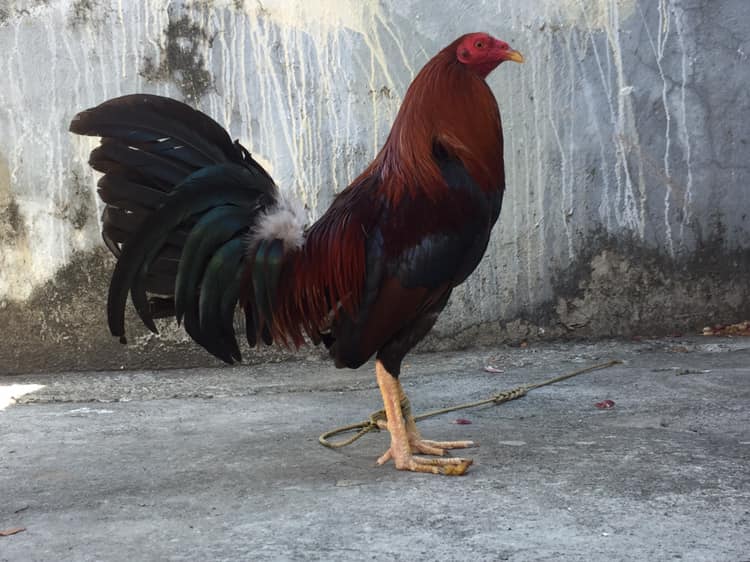Have you ever heard of the Allen Roundhead gamefowl? Although this bloodline may not be as popular as it was in its heydays, it is still highly sought after due to its credibility.
History of the Allen Roundhead
In Mississippi, Will Allen acquired a Boston Roundhead gamecock from Dr. Fred Saunders and crossed him with hens that blended Redquill and Grist Grady. Gradys are believed to have been developed by Col. Grist of Georgia through a succession of battle crosses. Among the breeds included were Claiborne, Shawl neck (Southern USA Whitehackles), Warhorse, and a touch of Spanish blue stock.
It would appear that the Boston cock had very strong pea comb genes to pass that characteristic on to subsequent generations after 100 years or so since all these breeds have straight combs.

For the past many years, he has owned many “Roundhead” fowl and has been involved in the sport as well. In the USA, this term refers to most pea comb fowl, which are black-breasted reds with white or yellow legs and do not show too much Oriental heritage.
Using the generic term “pea comb fowl” has become more commonplace than referring to a specific breed. The Allen-Shelton Roundheads are usually considered when discussing the breed. However, much of its development can be credited to R.E. Walt. In my younger days, many of the Roundhead gamefowl in Oklahoma were called “RE Walt Roundheads” rather than Allens.
You might ask about the Boston Roundheads who made the Allens. They arrived in the USA without an identification tag from Ireland. I was told these birds were Irish Whitehackles-bred, just like the more common English Whitehackles like the North Britons, the Earl of Derbies, etc. However, many Irish had pea combs.
In addition to the original Kearney (and Duryea) Irish Whitehackles, I believe the Irish Whitehackles bred by my Irish friend John Tynan were called Queen Anne Whitehackles.
As a result of the colonization of India, English breeders had access to the best Oriental fowl, including Asil and even Japanese. These Oriental bloodlines were added to the early English fowl of 500 years ago that weighed only around four lbs.-about the size of a Spanish cock now. The Oriental crosses increased the size to about 5 lbs. or bigger, similar to what American cocks are today.
Since the Irish did not mind the pea comb, the English breeders continued to breed straight comb and pea comb Whitehackles over the years. A whitehackle is a cock with a white under feather in the neck, which was the result of the old English custom of trimming the neck hackles close to the skin.
Blackhackle is a breed and crosses of Oriental/American that are known as Roundheads. Generally, their performance level lies somewhere in the middle. However, some Roundheads are very good, and some are quite poor. Many attribute the positive qualities of Kelso fowl to the combination of George Smith Roundhead blood (the same strain as Lundy) and Claret, which resulted in McClanahans; this was Walter Kelso’s initial cross.
Allen Roundhead Fighting Style
The Allen Roundhead gamefowl is known for its distinct fighting style, characterized by several key traits:
Calm and strategic
Unlike some aggressive breeds, Allen Roundheads are known for their coolness and composure in the cockpit. This allows them to assess the situation and make calculated strikes.
Waving and cutting
This is the most defining characteristic of the Allen Roundhead style. They utilize a unique technique of “waving” their legs to keep their opponent at bay while searching for an opening to land powerful cuts with their spurs. Their wings are also used defensively, blocking attacks and creating space for counterstrikes.
Intelligence
Allen Roundheads are considered highly intelligent birds. They learn quickly and adapt to different opponents and situations, making them unpredictable and difficult to defeat.
Stamina
Allen Roundheads are known for their impressive stamina, allowing them to fight long into the match. Their calm demeanor also helps them conserve energy during the fight.
Single-stroke power
While not the strongest breed in brute force, Allen Roundheads can deliver devastating blows with a single, well-placed strike. Their accuracy and timing are crucial to their success.
Fighting Generals
Allen Roundheads are often described as “ring generals” because they can control the fight’s pace and dictate terms to their opponent. They use their intelligence, stamina, and tactical prowess to outsmart and outmaneuver their opponents.
Here are some additional points to note:
- Allen Roundheads are typically not the first to attack, preferring to observe their opponent and wait for an opportunity.
- They are very good at defending themselves and avoiding attacks.
- They are also known for their mental fortitude and ability to recover from setbacks.
It’s important to remember that while these are the characteristic features of the Allen Roundhead fighting style, individual birds may vary in their specific tactics and strengths. Ultimately, the success of any gamefowl depends on a combination of breeding, training, and individual skill.
See Also:
- Red Quill Gamefowl History, Fighting Style, and More
- Radio Gamefowl Bloodline Profile and Fighting Style
- Roundhead Gamefowl Bloodlines History and Fighting Style
- Gamefowl Supplies List for Cockfighting Enthusiasts
- Albany Gamefowl Characteristics, Origin, and Fighting Style
